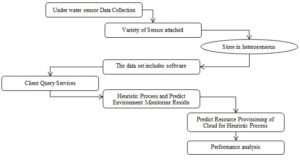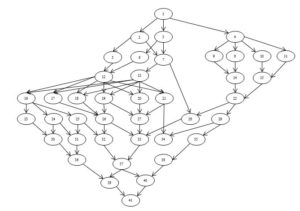Brief
- You will find the best dissertation research areas / topics for future researchers enrolled in Engineering.
- In order to identify the future research topics, we have reviewed the Engineering literature (recent peer-reviewed studies) on Cloud Computing and Multi-Objective Optimization.
- Cloud scheduling is the recent trend in cloud computing.
- Chemical reaction multi-objective optimisation is one of Nature-Inspired Optimization Algorithm.
- Chemical reaction multi-objective optimisation is one of the meta-heuristic algorithms SSA is a social animal foraging model.
- Chemical reaction multi-objective optimisation is used to schedule cloud task Directed Acyclic Graph (DAG) Scheduling.
In computer technology, cloud computing plays a vital role. It is considered as the emerging computing paradigm. Through cloud computing, various and extensive data can be stored in an open environment (Nayak et al., 2019). There are two basic objectives of Cloud Computing systems, that is the maximization of service performance and minimization of computing cost (Xiao & Li, 2019). The objective of cloud computing is obtained using a nature-inspired algorithm. Chemical reaction optimization is one of the nature-inspired algorithms. This algorithm is a kind of population-based optimization which can serve the general-based purposes through meta-heuristic technique. This can mimic the interaction of the molecules driving towards the minimum states or the stable state of its free energy (Xiao & Li, 2019). The Chemical reaction for multi-objective optimization (CRMO) algorithm helps to maximise the service performance together with it can minimize the computing cost at the system related to heterogeneity cloud computation or HCC (Xiao & Li, 2019). The Pareto frontier is considered very important for the cloud computing system. It is needed to schedule the solutions at first related to Pareto Frontier. It is because of the fact that Pareto –optimal based cloud scheduling can process through the interactive process. In this system, the provider uses to send the Pareto-optimal scheduling candidates to those users at first. In this case, the users have to select a scheduling point so that the maximum utility of the data processing services can be realized (Nayak et al., 2019). The directed acyclic graph (DAG) can be applied to the cluster-based system for executing task scheduling (Soto-Monterrubio. et al., 2016).

Chemical Reaction for Multi-Objective Optimization
DAG-based algorithm and architecture
DAG-based tasks are denoted through the nodes by the help of its architecture, as shown in the below figure.1.

Source Adopted From Xiao and Li.,(2019)
The directed edges are found to indicate an information flow which links one task with another. There are several nodes based on which the level of the workflow is needed to execute within parallel sources and in a consecutive level, but in sequence wise. Every stage has to be executed through blocking the tasks maintaining the successive levels. This task is needed to perform at the time when previous stages of the tasks are completed (Soto-Monterrubio. et al., 2016). In this scenario, the allocations can be performed through one resource only. For completing all those tasks, the requirement of energy and cost are more.
Performance and Cost representation through DAG scheduling
The DAG-based algorithm can be better judge through the ineffective collision of the inter-molecules. This type of collision is needed to simulate among two molecules, like x1 and x 2 used to collide to each other. In this case, two new solutions can be produced through the addition of small perturbations to the x1 and x 2 molecules. A new mechanism is processed in simulating this type of new mechanism (Angel & S.Hebsiba, 2016). The intermolecular ineffective collisions have to be applied here for exchanging the information through x1 and x 2 in a separate way.
This Chemical Reaction Multi-Objective Optimization (CRMO) algorithm is used in cloud task DAG-based scheduling. In the original case of Chemical Reaction Optimization or CRO, it is necessary to consider the potential and kinetic energy as the two types of energies which the molecule provides. Most of the case the potential energy quantifies the structure of the molecule and it is known as the objective of the functional value when it can evaluate the corresponding solution (Hebsiba & Angel, 2016). Also, it has been observed that kinetic energy can be tolerant of changing the favourable structure of the molecule itself. Hence, to adopt this kind of mechanism of the multi-objective optimization, it is important to check the Pareto-optimal theory which can improve the mechanism to guide the evolutionary population.
It will be done on behalf of the multi-objective Pareto optimal solution. Additionally, there are four elementary reactions which can be proposed for the DAG task scheduling. This process of the chemical reaction can be found for making the multi-objective optimization in the below algorithm. In this case, there is a scheduling sequence conducted through the topological sort on DAG (Xiao & Li, 2016). This molecule of the CRMO system will be represented as the integer vector and in this case, every element will represent the processor as the number of the corresponding task which will be scheduled on. Other than this there is decomposition metric (α) and the factor of synthesis criterion (β). Both these factors are utilised while considering the decomposition mechanism through the DAG-based scheduling. The maximum utilization of molecules indicates the maximization of the performance and in other words, minimization of the cost of the user data in the cloud computing process (Singh, et al., 2018). The below algorithm supports the mechanism followed in this kind of ineffective collision so that maximum information can be shared.
Algorithm: Ineffective molecular collision
1. Input: Module x1,x2, with their profile
2. obtain x’1 from x1 and x’2 from x2
3. Calculate PE’x1 and PE’x1
4. sum=0;
5. for i=1:Numobj do
6. Einter(i) = (PEx1(i) + PEx2(i)+ KEx1(i)+ KEx2(i) – PEx1’(i) + PEx2’(i)
7. End for
8. if Einter(i) ≥ 0 then
9. 9.sum=sum+1
10. end if
11. Obtain x’ from X
12. Calculate PEx’
13. sum=0
14. for i= 1: Numobj do
15. if PEx (i) )+ KEx(i) ≥ PE’x(i) then
16. sum=sum+1
17. end if
18. end for
19. NumH itz = NumHitx+1
20. if sum-Numboj then
21. Get q randomly in interval [KElossRate,1]
22. KEx1’(i = Einter(i)×q,i=1,….. Numobj
23. KEx2’(i = Einter(i)×(1-q),i=1,….. Numobj
24. x1=x1’,x2=x2’
25. PEx1’(i) + PEx2(i), i=1,…..Numobj
26. KEx2’(i)+ KEx2(i), i=1,…..Numobj
27. End if
28. if sum > 0 then
29. p1=x1’, p2=x2’
30. end if
31. Output=p1,p2
It has been observed that for DAG-based task various molecular dynamic codes have to be adopted. One is the application of DAG along with eight sub-tasks in the below figure.2

Source Adopted From: Xiao and Li.,(2019)
Also, another DAG graph of molecular dynamics is shown here in the below figure.3.

Figure 3: DAG graph related to molecular dynamic code
Source Adopted From Nayak, et al., (Nayak et al., 2019)
In the case of molecular dynamic code, 41 sub-tasks are required. In this case, the simulation optimization experiment supports the maximization in data transferring techniques. The CCR or communications to computation ratios for DAG are varied as 0.1, 0.5, 1, 2 and 5. In this case, the range of percentage of the computation cost can be found as, 0.1, 0.25, 0.5, 0.75 and 1. The bigger the value of CCR, the DAG application would support the communication-intensive tasks. For this reason, the CCR value is very much important as it impacts the performance as well (Nayak et al., 2019). For different CCR value, performance is varied and thus the DAG application also becomes heterogeneous in nature. Thus, the performance of this algorithm will be evaluated and that can be compared against the existing solutions to find out a Pareto-optimal solution (Singh et al., 2019). This solution indicates the maximization of the performance and also minimization of the cost of the user data in cloud computing.
Conclusion
The maximization of performance and simultaneously minimization of cost is not a simple task. The Chemical reaction for multi-objective optimization (CRMO) algorithm helps to maximise the service performance and can minimize the computing cost of heterogeneity cloud computation (HCC). The Pareto frontier is considered very important for the cloud computing system. It is needed to schedule the solutions at first related to Pareto Frontier. It is because of the fact that Pareto –optimal based cloud scheduling can process through the interactive process. In this system, the provider uses to send the Pareto-optimal scheduling candidates to those users at first. In this case, the users have to select a scheduling point so that the maximum utility of the data processing services can be realized. The directed acyclic graph (DAG) can be applied to the cluster-based system for executing the task scheduling in cloud.
Future Scope
- The DAG-based algorithm is also useful for finding out the data encryption standard. This data encrypted standard is needed to publish through the resource-provisioning in Cloud computing (Choudhary et al., 2018).
- It can be used for improving the high accuracy and also the high resolution (Nayak et al., 2019).
- The optimization is based on the minimization of execution time or the cost of executing the application in the near future (Xiao & Li, 2019).
References
- Angel, P.A. & S.Hebsiba (2016). Analysing Optimized Cloud in Resource Provisioning using Firefly Algorithm. 2 (10). p.pp. 156–160.
- Choudhary, A., Gupta, I., Singh, V. & Jana, P.K. (2018). A GSA based hybrid algorithm for bi-objective workflow scheduling in cloud computing. Future Generation Computer Systems. [Online]. 83. p.pp. 14–26. Available from: https://linkinghub.elsevier.com/retrieve/pii/S0167739X17303217.
- Nayak, J., Paparao, S., Naik, B., Seetayya, N., Pradeep, P., Behera, H.S. & Pelusi, D. (2019). Chemical Reaction Optimization: A Survey with Application and Challenges. In: [Online]. pp. 507–524. Available from: http://link.springer.com/10.1007/978-981-13-0514-6_50.
- Singh, V., Gupta, I. & Jana, P.K. (2019). An Energy Efficient Algorithm for Workflow Scheduling in IaaS Cloud. Journal of Grid Computing. [Online]. Available from: http://link.springer.com/10.1007/s10723-019-09490-2.
- Soto-Monterrubio., J.C., Santiago., A., Fraire-Huacuja., H.J., Frausto-Solís, J. & Terán-Villanueva, D. (2016). Branch and Bound Algorithm for the Heterogeneous Computing Scheduling Multi-Objective Problem. International Journal of Combinatorial Optimization Problems and Informatics,. [Online]. 7 (3). Available from: https://ijcopi.org/index.php/ojs/article/view/23.
- Xiao, X. & Li, Z. (2019). Chemical Reaction Multi-Objective Optimization for Cloud Task DAG Scheduling. IEEE Access. [Online]. 7. p.pp. 102598–102605. Available from: https://ieeexplore.ieee.org/document/8758177/.

